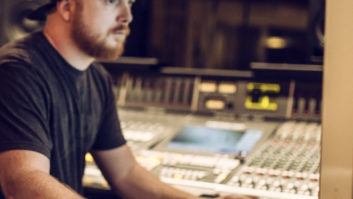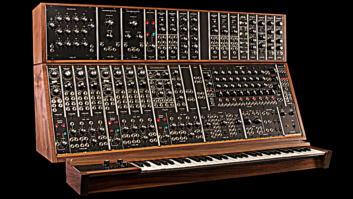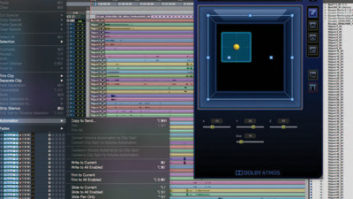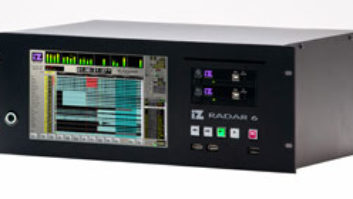Like it or not, we are fast approaching the time when lineartape-based machines will be a thing of the past. In 1992, RADAR(distributed by Otari) was the first stand-alone system to offerdisk-based, 24-track recording. Now distributed by iZ TechnologyCorporation — the original creators of the RADAR system— RADAR 24 bridges the gap between the traditional lineartape decks and the more elaborate DSP-based editing systems.Offering a simple, stable and solid product is the philosophy thathas always reigned at iZ, and RADAR 24 continues that approach,while offering new systems at a fraction of the cost of itspredecessors.
THE BASICS
The unit I tested consisted of the RADAR 24 (a four-rackspaceunit), the optional Session Controller, a 48-channel meter bridgeand the Nyquist 24/96 I/O board set. All the units are attractiveand well-made, and convey a feeling of quality. The front panel hasan On/Off switch, floppy drive, 18-gigabyte SCSI drive in aremovable Kingston Fast-Wide Ultra SCSI hard disk carrier, and a9.2-gig 2x DVD-RAM drive for backing up the system and archivingprojects. Operating system chores are handled via an internal IDEdrive, while digital audio is written to the removable high-speedSCSI drive. Besides the DVD-RAM drive, factory installed backupoptions are numerous, including Exabyte Eliant, Mammoth, MammothLite, AIT and Orb.
The unit’s chromed rear panel features six sets of DB-25connectors for 24 tracks of audio I/O, as well as three sets ofDB-25 TDIF connectors (with an additional three sets of DB-25connectors for optional ADAT and multichannel AES for a total of 48digital I/Os, which can be used simultaneously with the analogI/O). Stereo AES/EBU and S/PDIF connectors round out theselection.
Sync connections are via two pairs of BNC connectors forwordclock and video (house) sync, and there are also standard MIDIIn/Out/Thru and Sony 9-pin machine control connectors. Theseprovide access to RADAR’s SMPTE timecode chase lock/generator, MIDItimecode chase/generator, video sync, wordclock sync and machinecontrol. Additional interfaces include an Ultra Wide SCSIconnection for external drives, standard parallel port connectors,keyboard and mouse sockets, and the proprietary RADARLINKconnector, which allows for simultaneous operation of up to eightRADAR 24 (or RADAR II) units.
In addition to audio levels, LEDs on the meter bridge indicatethe status of the track, including solo and edit states. All ofthis eye candy makes it entirely possible to operate the RADAR 24and Session Controller without a monitor, though a monitor will benecessary if you intend to operate RADAR with the (included)standard PC keyboard alone. Projects can be named, and all menuoptions can be accessed using the front panel controls and the LCDwindow.
IN SESSION WITH RADAR 24
Anyone familiar with autolocator remotes will have no troublegetting around on the Session Controller. The familiar standardtransport buttons, jog wheel, QWERTY keypad, numeric keypad anddedicated hot keys make all operations fast and efficient. Most ofthe buttons on the Session Controller contain an embedded LED thatindicates status. The current operation is displayed both on theLCD screen on the Session controller itself and on a similarvirtual window in the RADARVIEW screen (more on this later).
All connectors and cables are clearly labeled, and I found thesetup to be about as simple as it gets. However, when I plugged ageneric 19-inch computer monitor in the standard SVGA connector andflipped the Power switch, I found that RADAR generates a bit morefan noise than is necessary. I have been building PC-based audiosystems for years and have found that a lot can be done to lowerthe noise level, simply by carefully choosing the case fans, powersupply and CPU fans. In an ideal situation, the RADAR units shouldbe located in an isolation box or in a separate room away fromcontrol room or recording areas. Perhaps this is not as big anissue as it first appears. I spoke to the people at iZ and wasinformed that RADAR is now shipping with a much quieter powersupply and fan.
I repositioned the unit outside of the control room andrebooted. As RADAR is based on the PC platform running the stableand reliable BEoS 5 operating system, the familiar PC“post” screen appeared and was quickly followed by theBEoS logo. This was briskly replaced by the RADARVIEW track screenand after that, the PC and BEoS operating system became completelyinvisible to the user. RADARVIEW — the one and only screenyou have to deal with — is an overall graphic view of all 24tracks, similar to the track view screens seen on almost allediting software. Similarly, individual tracks can be zoomed intoand out of for detailed waveform editing. Overall, I foundRADARVIEW to be simple, good-looking and intuitive.
The sound of a digital recorder is primarily the sound of itsconverters, so I first checked out the AD/DA section to see whatall of the fuss was about. A bluegrass session with acousticinstruments gave me a real chance to hear the detail the converterswere capable of, and I was not disappointed. A Martin D-28 boxguitar came though with a sheen I had not previously heard, and thetransient punch of the banjo was remarkable. Such clarity is notinexpensive — the Nyquist 24/96 card is a $2,995 option.
Next I decided to try a real-time digital transfer from afriend’s Tascam DA-88 via the TDIF connectors. Because the DA-88offers SMPTE, MIDI and Sony 9-pin sync, and also included the SY88synchronizer, I had a chance to test almost all available syncoptions. I didn’t expect to find any issues with RADAR’s synccapabilities, and I didn’t. Later, using both SMPTE and MMC whereappropriate, I was able to achieve rock-solid sync with my studioPC running Logic Audio, Cakewalk Sonar and Cubase 5.0. This bringsme to my second and final gripe with RADAR. At the time of writing,RADAR 24 was not able to import projects from other editingsystems, nor is it able to import audio files via the DVD-RAMdrive; in fact, only small .WAV files can be imported via thefloppy drive. [Editor’s Note: Several of these concerns have beenaddressed with the upcoming release of Version 3.10 software. Seethe “RADAR 24 Software Update” sidebar for details.]However, iZ promises that RADAR 24 will soon have the ability toimport Pro Tools projects, and other file-import capabilities areplanned.
Once the tracks were in RADAR, it was time to explore theediting possibilities. Those accustomed to editing on moreelaborate, computer-based DAWs may find the editing functions ofRADAR 24 rather limited. However, as RADAR is intended as a directreplacement for linear tape machines, the developers at iZ decidedto stick to the editing basics: Anyone who is familiar with otherdigital editing platform will not have a problem getting around onRADAR 24 and will appreciate its plusses, such as real-timewaveform rendering, the ability to perform multiple in/out pastemarks on-the-fly, and its dedicated controls on the hardwarecontroller for fast, one-touch setting of in/out/sync points and 10Locate buttons.
After defining the in and out point of the area to be edited,the user can then place it in a virtual clipboard from which it canbe cut, copied, pasted, moved, erased, slid, looped andreverse-pasted. It is a simple matter to position the clip, eitherby using the jog wheel or by using the autolocator, to find apre-defined point. All edits can be auditioned, and there are up to99 levels of undo. All of this is so simple that it is quitepossible to edit on-the-fly during a session, something you may beafraid to try on a more complex system. Another nice feature is theMark Sync button, which allows sound effects and audio cues to beeasily and precisely positioned during video post-production.
In keeping with the tradition of simplicity, archiving andretrieving RADAR projects via the DVD-RAM drive could not beeasier. From the LCD window, you can choose either the Backup orRestore menu, pick the project you want to archive or load and hitEnter. RADAR does the rest, and the 9.4-gig capacity of the DVDdrive eliminates the hassle of backups from slow tape loads, as inearlier versions of RADAR, or multiple CD-Rs.
Readers familiar with the previous RADAR and RADAR II arealready acquainted with the superb sound quality, 24-hour techsupport and bulletproof stability of RADAR 24. The list of artistsand producers who have recorded using RADAR reads like a“Who’s Who” of the recording industry. So, what doesthe latest incarnation of RADAR bring to the table? RADAR 24features an improved user interface and supports sample rates of upto 192 kHz. Add to that the robust BEoS 5 operating system,SOUNDMASTER compatibility and 9.4-gigabyte 2x DVD-RAM backup, andyou have a package that’s fairly hard to beat. Did I mention price?The RADAR 24 system I tested priced out at $10,870 retail, while asimilarly configured RADAR II system would have sold for over$20,000. Quite a reduction!
iZ Technology Corporation, 8988 Fraserton Court #214, Burnaby,B.C. V5J 5H8, Canada; 604/430-5818; fax 604/430-5828; www.izcorp.com.
Pete Leoni is the technical director at QPerformance, adivision of East Coast Music Mall. He can be reached at[email protected].
RADAR 24 Pricing
The base RADAR 24 system is $4,995, with an 18GB drive;24-channel TDIF I/O; 2 channels of AES/EBU and S/PDIF I/O;SMPTE/MTC/AES/video/word/9-pin sync; standard KC-24 keyboard; portfor SVGA monitor; and all necessary software. By selecting from awide range of options, RADAR 24 can provide a customized system tofit a variety of user needs.
Options include:
Session Controller: $1,195, with 33-foot cable. Thisfull-function autolocator/controller features an LCD screen,dedicated transport controls, jog wheel, macro keys, dedicatedediting keys and menu shortcut keys. An optional 66-foot extensioncable is $150.
Meter Bridges: The $495 Meter Bridge 24 is designed forconsole-top or Session Controller mounting, providing full-range,24-track LED metering without having to use the onscreen meters.The Meter Bridge 48 ($795) offers 48-track metering fordual-RADARLINKed RADAR 24 or RADAR II systems.
Digital I/O: Twenty-four channels of 96kHz-capablepathways in AES/EBU format on three DB-25 connectors, $995.
Classic Analog I/O: Essentially the same 24-channel,48kHz AD/DA converters used in RADAR II, $1,695.
Nyquist Analog I/O: Twenty-four channels of 48/96 kHzAD/DA conversion, $2,995. The $3,995 S-Nyquist Analog I/O option issimilar but offers improved conversion.
Drives: The standard 18GB Barracuda drive that comeswith RADAR 24 can be upgraded with a variety of optional hard disksranging up to 36 GB, for nearly three hours of 24-track recordingat 48 kHz.
Backup: An assortment of auxiliary drives are offeredfor archiving or backup, including: double-sided 9.4GB 2x DVD-RAM,$695; 7- to 14GB Eliant 820S 8mm tape drive, $1,795; 14- to 28GBMammoth LT drive, $1,995; 20- to 40GB Mammoth drive, $2,995; andthe 60- to 150GB Mammoth 2, $4,995.
Cabling: To access the TDIF digital or analog I/O,you’ll need D-25 sub-to-XLR (or -TRS) breakout snakes. These areavailable from numerous vendors, ranging from the ordinary to theexotic — depending on your budget needs and tastes, but theymust be figured into your RADAR budget.





